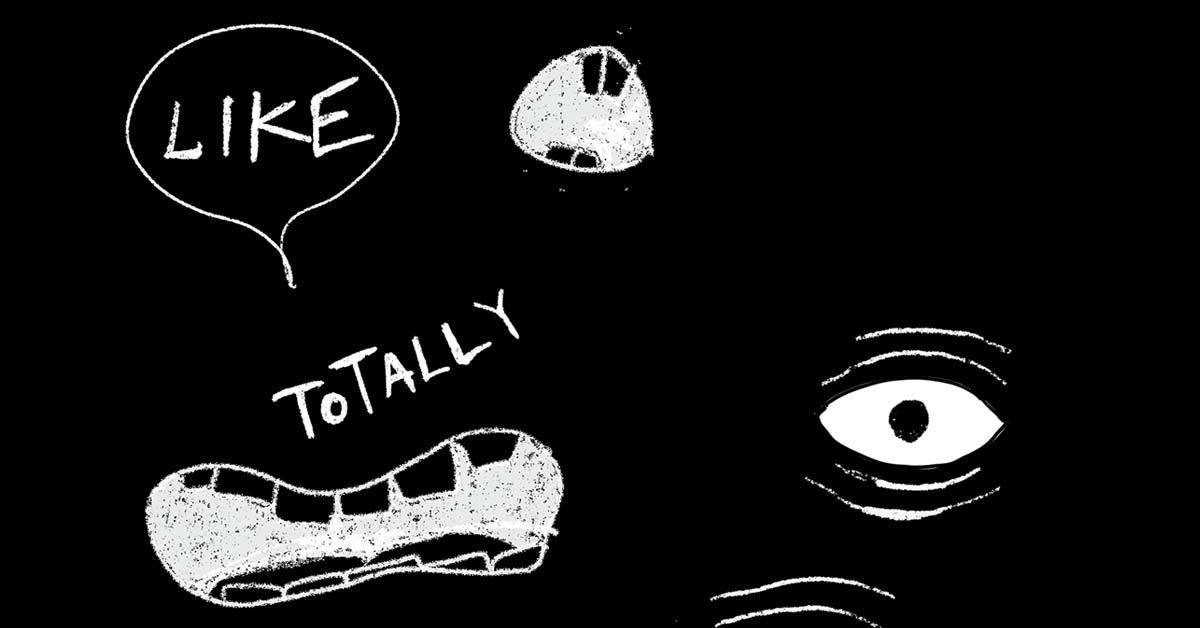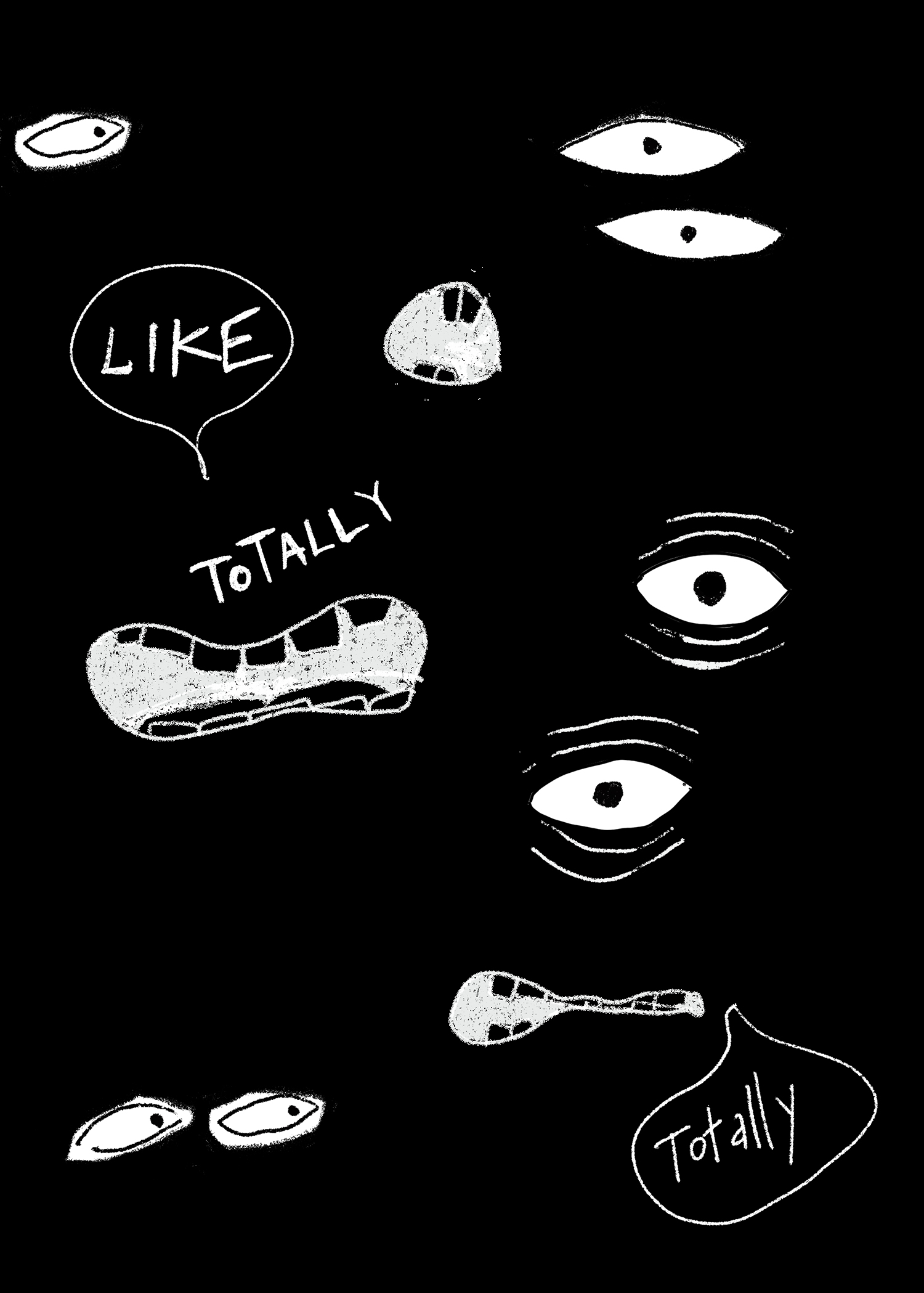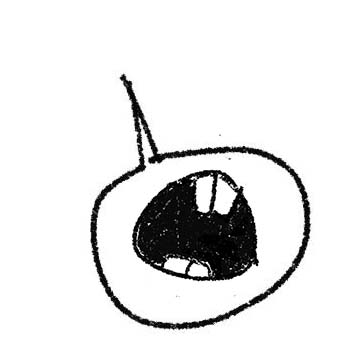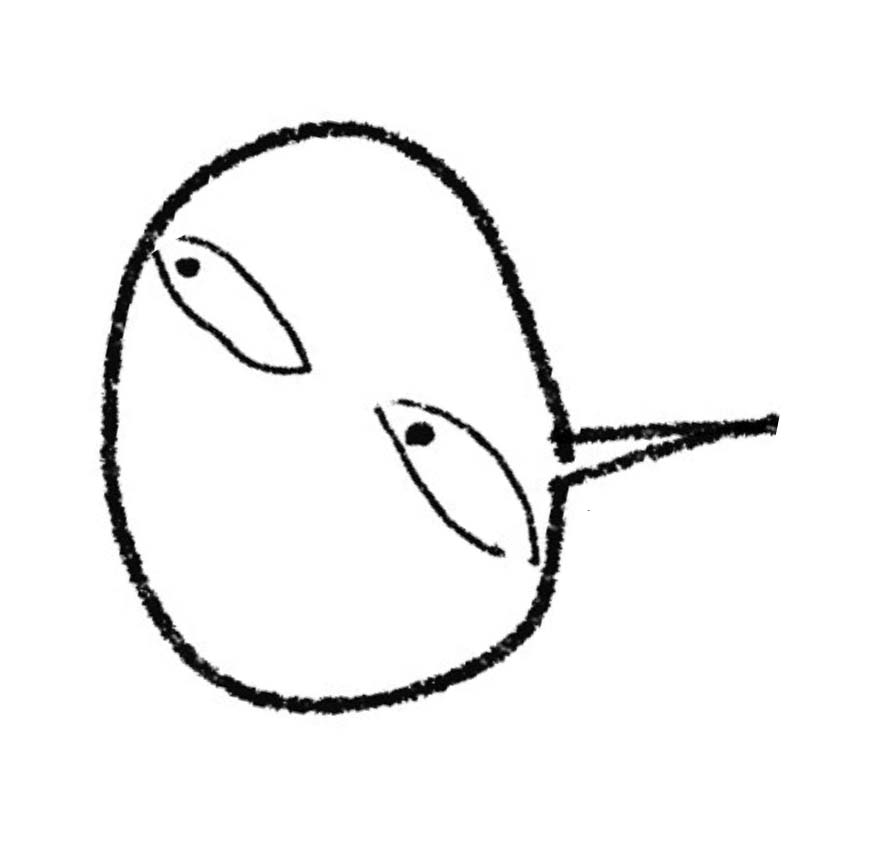

This is Like, Totally Weird
Why your kid talks like an American.
By Don Rowe
Illustration Imogen Greenfield
It’s every parent’s worst nightmare. In an attempt to deal with the grinding pressures of modern life, you’ve let your kid have a bit of screen time — just a few episodes of Paw Patrol, or maybe a bit of Moana while you get dinner ready. Or perhaps you’re on a long road trip, and you let them use the iPad to watch YouTube Kids, deploying the content filters to make sure Mr 3 and Ms 4 won’t accidentally see drug cartel execution footage or fall down an alt-right rabbit hole.
You pull over to fill up the tank and your partner decides to get snacks. “Do you want anything?” she asks, opening the car door. Then it happens. Looking up, cross-eyed, they tell her: “Yes, Mom, I want candy from the gas station. And can you put my trash in the garbage?”
Have their brains melted? Are cerebral fluids about to run out of their nose and on to their Frozen bib? Has your toddler been replaced with a grown yet tiny man escaping post-Trump America? Are you going crazy? Are you . . . a bad parent?
Kiwi kids’ accents are changing. Maybe you’ve noticed it yourself. Maybe someone else has asked you whether you adopted a child from the Valley, due to their oddly Californian dialect. Or maybe there’s something else going on. Something more subtle, widespread — and irreversible.
Rachel Hill lives in Wellington with her husband Tyson and their two children, Otis, 15, and Isa, who is eight, with dark curly hair, a cheeky smile and a hybrid American-British accent — surprising, given the fact she has spent her whole young life in Upper Hutt. Her older brother was the first to notice, asking his parents, “Why does Isa speak in an American accent?” when she was about four years old. She was pronouncing distinctly American words with an American twang: candy, vacation — the “usual suspects”, Hill says. “Of course, I felt guilty because Isa has had an iPad since she was three or four. She was using our devices so we just got her one of her own.” Hill was shocked, she said, and perhaps a little dismayed. “I definitely don’t want her to have a strong Kiwi accent, but I would still prefer that over an American accent.”
Another concerned mother is Sarah Conder, a graphic designer from Manurewa, who was also alerted to her son Noah’s rolling American r’s by his sibling. Noah’s little brother, Grayson, started correcting his pronunciation, telling him “‘It’s not No-er, it’s No-uh!”, Conder recalls. “I initially thought, ‘Oh no, I’m one of those parents who has let their child watch too much TV’,” she says. That’s a common reaction — another parent I spoke to, when asked why their kid had a funny little accent, replied simply “too much iPad”.
Sarah Lee, a teacher at an intermediate school in Hamilton, has noticed the trend too. “In the last couple of years I have observed more and more students starting intermediate and speaking with an American accent, despite having not lived in America — or even visited.”
As far back as 2012, before streaming services, phones and tablets made it even easier to give in to the temptation to distract the kids with a bit of TV, linguists were noticing the impact of American television on some children’s speech. In a New Zealand Herald article called “Kids, like, totally pick up accents”, linguists assured worried readers that any accent change would be temporary, shed after their child started school as they began to sound more like their peers. But what if your child’s classmates all have the same linguistic tics they do?
The New Zealand accent is the only native-speaker variety of English to be entirely known and catalogued from its genesis. According to Professor Elizabeth Gordon’s Finding Our Own Voice, a seminal account of the New Zealand accent published in 2008, our recognisable “colonial twang” was first identified in the late 19th century. Before long, she writes, critics such as the Australian-born Charles Baeyertz were condemning the deviation from “cultivated British speech” in their literary journals. “A bad local accent is not bad because it is local, but merely because it is vile on general principles,” he opined in the early 1900s in one edition of his monthly journal the Triad. “It is hateful as a bad egg is hateful — because it offends a decent and wholesome sense.”
By 1877, when education for Pākehā children became compulsory, the hateful, bad-egg twang began to spread from host to host inside the country’s classrooms. What constitutes a classic New Zealand accent is somewhat up for debate, given how variable some aspects of it can be — the rolled Southland ‘r’, for example, is certainly recognised as distinctly Kiwi, but for years wasn’t found anywhere else in the country. Early academics believed the New Zealand accent fermenting in the minds of children was a bastardised form of Cockney. In 1924, writing for the Educational Gazette, New Zealand speech expert Dorothy Stewart described Cockney as “intrinsically ugly”. “[It] offends the cultured ear; second, it indicates slovenly vocal habits, and suggests equal carelessness in other respects; and third, it is associated with the uneducated, even the vulgar . . .”
Gordon writes that this characterisation was erroneous and borderline malicious. Cockney was already used in Britain as a coverall category for “lower-class” speech — the transplanted implication was that colonial Kiwis were the dumbest of the destitute, particularly in the minds of those with a greater connection to the motherland. But though used as a slur, the Cockney label had some truth to it. As well as being spoken by the working class in the East End of London, a similar form of the dialect was common among labourers in the southeast counties of England from which a high proportion of settlers to Aotearoa came. The New Zealand accent developed out of the way they spoke — with a dash of Scots and other influences mixed in. Those with the strongest “colonial twang” were indeed from families without the means to return to England. “It is not surprising, therefore, that the earliest examples of the New Zealand accent don’t come from the well-to-do, but rather from poorer people,” writes Gordon.
By the middle of the 20th century, the last remaining bastions of the Queen’s English, with its posh, round o’s and plummy tenor, were private schools and the nation’s broadcasting studios. Bulletins from the 1960s and 70s sound as though they were recorded in a bathroom at Westminster, which is funny now, but was the height of dignified reporting at the time. As we shook off some of our colonial hang ups (at least where the pronunciation of vowels was concerned), New Zealand evolved to New Zillund. This was not the final mutation of our accent — and once again, the change is most noticeable in the classroom.
“There is something happening with kids,” linguistics professor Dr Andreea Calude says. “With a lot of Auckland kids — and it may be spreading — there is a change coming in.” According to Calude, what parents might be witnessing is not the infiltration of American media into the minds of their children, but the development of a new accent entirely.
Calude, editor-in-chief of the journal of the New Zealand Linguistics Society, Te Reo, and a professor at the University of Waikato, says the phenomenon is akin to linguistic evolutions in places like London, where the predominantly Cockney accent has been replaced with an “international English” twang. Calude refers to it as an “informal preferred accent”. “New Zealand is now very multicultural and one of the things that happens when lots of different varieties meet in this melting pot is that you get a bit of a levelling,” she says. “You pick up this and that feature from different accents which are brought in together.” This creates a new accent which is not quite American, not quite British, but combines elements of each (and others besides).
An accent is made up of vowel pronunciation and the way in which sounds move around the mouth. For example, the ‘r’ sound can be trilled like in Scottish English (“cheerrrio!”), rolled like in the Romance languages (“arrrivederrrci!”), or given a hard emphasis which most New Zealanders would associate with American English (“see you laterrr!”). In other accents, the glottal stop replaces hard consonants — think “buh” instead of “but”, or “ow” instead of “how”. So while kids who say “carrr” rather than “cah” may sound like they’ve stepped off the set of iCarly, Calude says that this is only one among many of the sounds that are evolving in this new way of speaking.
Children begin the process of language acquisition while still in the womb. Babies are tuned to sound; they’re able to recognise their mother’s voice through the placental lining, and they are already starting work on distinguishing it from other people’s. Calude believes it is at this early stage that accent acquisition begins — and research indicates that a child’s first spoken word may be in the accent of their parents. This listening phase is the first part of the two-step process of learning an accent. First, a child learns to hear the sounds that are important for a language and the sound contrasts that distinguish it. Then, there is the production — getting the articulators in place so you can repeat the words correctly. Children do this easily, but something happens around puberty where accents become harder to change and to pick up. Linguists call it the “critical age” hypothesis.
“People misunderstand that to mean that you can’t learn another language after puberty, but that’s not true,” Calude says. You can learn another language, but to sound like a native speaker to another native speaker is much harder. “It’s in this younger stage where accents are picked up, especially at school.”

Has your toddler been replaced with a grown yet tiny man escaping post- Trump America? Are you going crazy? Are you . . . a bad parent?
Once children start school they are more influenced by what their peers sound like than by the characters in the shows they watch. It is possible we have now reached the point where enough children start school with a twang that it actually spreads and sticks. The new flavour of accent in New Zealand, Calude says, seems to have emerged “for the typical reasons why varieties emerge”. That is, for social reasons. Accents enable people within a particular community (like a school cohort) to express concepts through a cohesive and comprehensible shared framework. They signify belonging and a collective understanding.
Lee, the Hamilton intermediate school teacher, has noticed that this new accent is prominent in recent immigrants who have English as a second language, who may pick up their American inflections through watching TV shows such as the sitcom Friends. But a Yankee twang is increasingly common in her New Zealand-born students — particularly those who are allowed to spend time on social media. “Apps like Instagram and TikTok allow students to interact with and mimic American social media stars, or mime to their American accented scripts and voice excerpts,” she says. TikTok in particular is heavily based on lip syncing, where users create videos in which they mouth along to song lyrics or audio clips. “Students will spend hours repeating lines and phrases in American accents until they perfectly match the audio or visuals in a popular Vine or TikTok video,” Lee says. “I feel that this repetitive rote learning of American pronunciation also plays a part in the increasing number of students speaking with American accents or using American terms and vocabulary.”
On top of this, what many parents might perceive as an Americanised way of speaking may not be so at all. Some Polynesian accents, particularly Samoan and Tongan, feature an emphasised ‘r’ not dissimilar to the American one (think “firrrst”, or “sisterrr”). In 2018, academics running a long-term linguistics study into emerging dialects in New Zealand found that what used to be known as the “Southland r” (most obvious in words like “horse” or “cart”) was now found all over the country, but particularly in suburbs like Auckland’s Mt Roskill and in South Auckland, which are culturally mixed and have a high number of Pasifika community members.
This hypothesis rings true for Conder, whose son attends Alfriston School in South Auckland. “At Noah’s school there is a very diverse range of cultures,” she says. If he’s listening to his classmates and chatting with his friends all day, well, it sort of makes sense that he might pick up their modes of speech.
Hill thinks her daughter Isa’s accent is situational. When she speaks to someone in a position of authority, like a doctor or a teacher, the accent is exaggerated. I notice it too — kids may say the darndest things but they are notoriously difficult to interview, seldom offering much more than a shy “I don’t know”. There it is when Isa talks to me, an “I don’t know” straight from Nickelodeon. Noah’s accent comes through the most when the subject is Minecraft or a particular Twitch streamer.
My brother Reese is also a 12-year-old Minecraft obsessive. While most parents worry their children’s eyes will turn square from the screen, I worry Reese’s entire head will turn cubic, or that he will take to the house with a pickaxe, looking for ore. Reese’s first language was te reo Māori and for most of his childhood, te reo Yankee was his second; pa-na-na and b’neh-nas. Today that accent has softened, except for when the subject is Minecraft. To listen to Reese, it’s not “Moincruhft”, but “Mayncraaft”. And I’m increasingly familiar with what “heppens” when he says “hahppens”.
Calude says this is an example of what linguists call “style shifting”, which is something all of us do. Just as most adults put on a certain voice when they’re talking to their boss, kids change the way they speak to more accurately communicate emotions. “It’s not just about presenting a certain persona — like Mum or Dad, or a good employee, or a knowledgeable journalist — but you might also adapt your speech because you want to signal various social characteristics,” she says. “A typical one is friendship. If you like the person you’re speaking with, you’re much more likely to accommodate their speaking style. This is when you’re going to take on that accent. And if you dislike someone, there have been interesting studies that show you start to distance yourself by sounding less like them.”
Consider the way the late great comedian Billy T James or the rapper Tom Scott might pronounce “fellow”, “far” or “officer”. Compare that to the way Mike McRoberts would say them on the 6pm news. The first two speakers use what’s known as “bro talk”, a unique form of Māori-New Zealand English which retains the full vowel sounds of words like “goose” or “use”, and has become increasingly popular. According to Calude, the uptake of bro talk may be indicative of a growing national pride, as its use can signal an affinity with Māori language and culture. “You’re demonstrating an affinity with that social group. One of the most obvious features is the use of Māori loan words, like kai, whānau, kia ora. There is also the idea of a cultural cringe, that the New Zealand accent is a terrible twang, and I feel like we are moving beyond that as we think more about our attitudes to social groups in general.”
Research shows that we don’t think of accents in a neutral way. Language and accents are not just tools for communication, they’re indicators of class, status and belonging. Just as there was a backlash to news presenters and politicians in New Zealand moving away from the Queen’s English, so too is there a stigma towards elements of bro talk today. Often, the accent is conflated with stupidity, or mimicked and exaggerated for comedic effect. In the same way that Simon Bridges’ broad accent has been ridiculed, bro talk is sometimes used as a lazy shorthand for anyone of a lower intelligence or socioeconomic status. This occurs in every country with numerous ways of speaking, Calude says. “We use accents to judge people and it can be quite sad.” There have been experiments conducted in the United States which show that when someone with an African-American accent calls up and asks about renting a house, they are told the rooms are full. When the caller ringing up sounds like a white person, they are suddenly available. “I can imagine as a parent there could be a concern that their child is not speaking with what they consider as a prestige accent,” Calude says.

My little brother spends so much time playing Minecraft I worry his entire head will turn cubic, or that he will take to the house with a pickaxe, looking for ore.
All accents are linguistically viable, in that a Scouser can communicate with a fellow Liverpudlian just as effectively as someone from Brooklyn can chat with another Brooklynite, but attitudes towards accents often reflect a wider attitude towards a nation or culture. Resistance to Americanised English could be a backlash to American values or a perceived American homogeneity. But Calude says that an increased ability to style shift may not be a bad thing at all.
Just as hieroglyphics gave way to writing with an alphabet (which is now often accompanied by emojis, modern hieroglyphics rich with subtext and nuance), verbal communication styles mutate and shift. Ultimately, the purpose of all communication is to be understood. Speech itself is an attempt to make up for our lack of telepathy, and accents — like tone or cadence — are one of many tools we use to bridge that gap.
Provided kids also develop situational awareness, having a range of vocabulary and sounds will be a net benefit to their communication, says Calude. It’s less likely that children’s brains are bubbling away like thermal mud from too much screen time and more likely that they are developing a remarkable ability to get their point across. Go figure!
Don Rowe (Ngāi Tahu) is an award-winning feature writer and law student living in Wellington.
This story appeared in the December 2021 issue of North & South.


